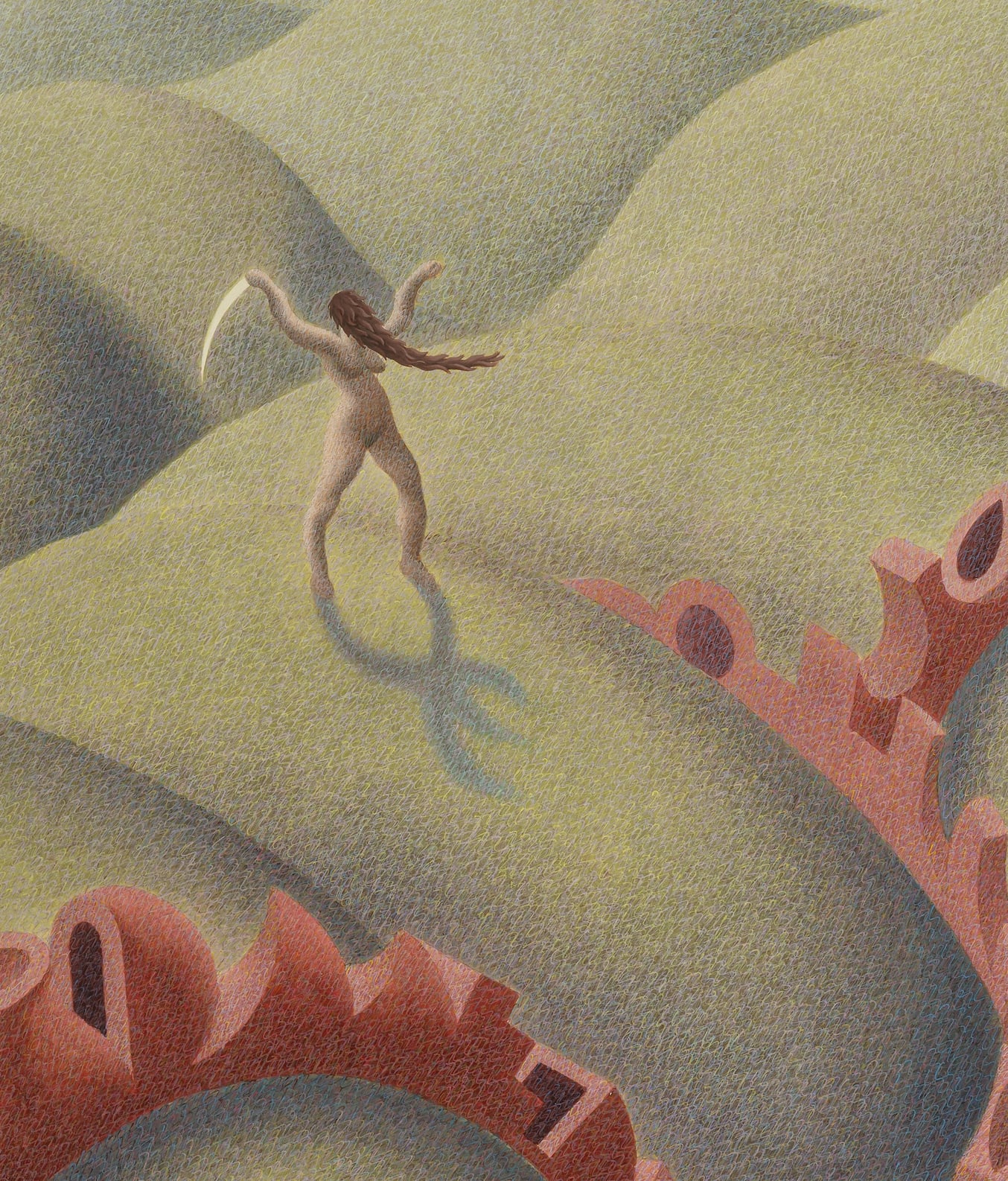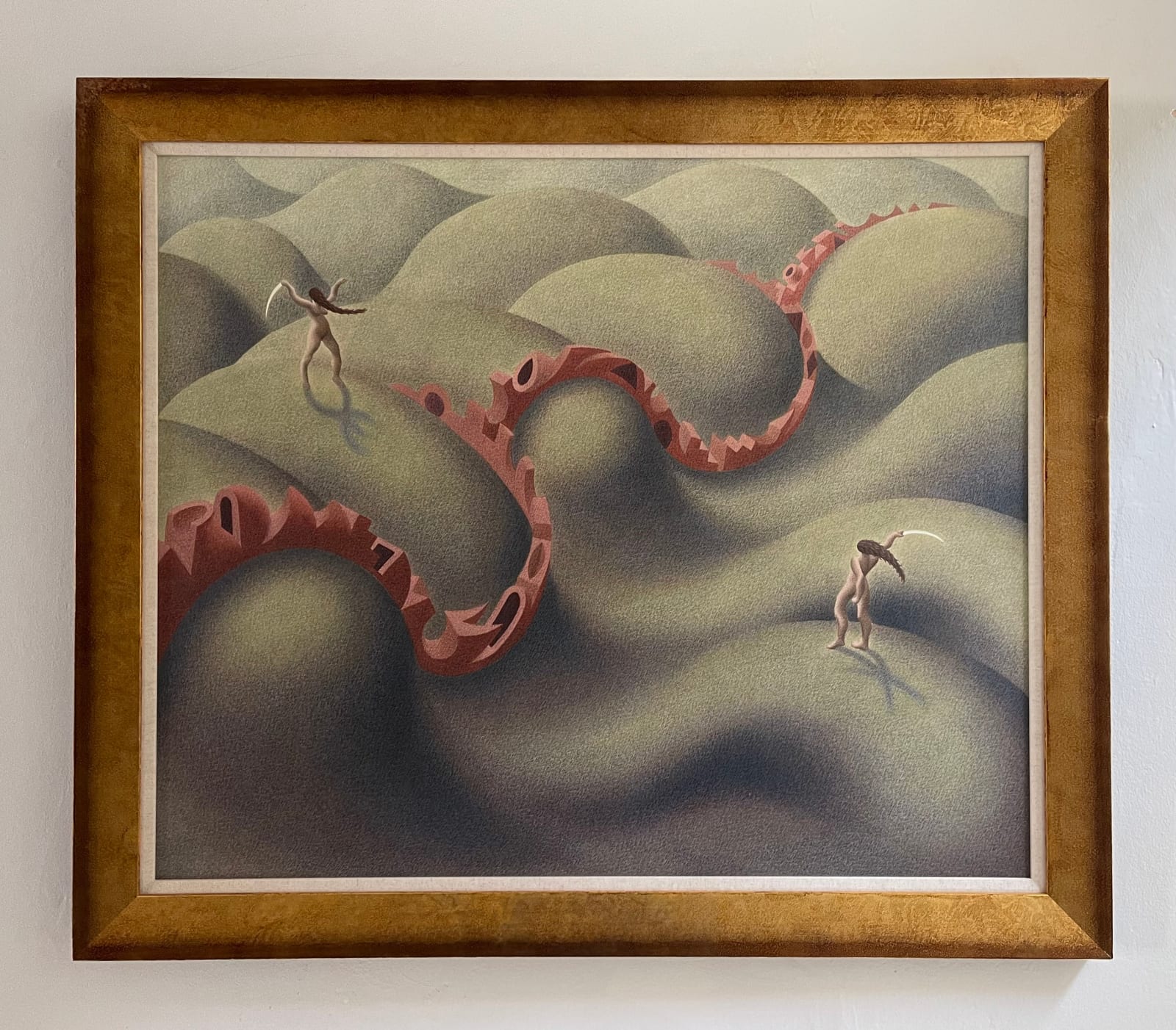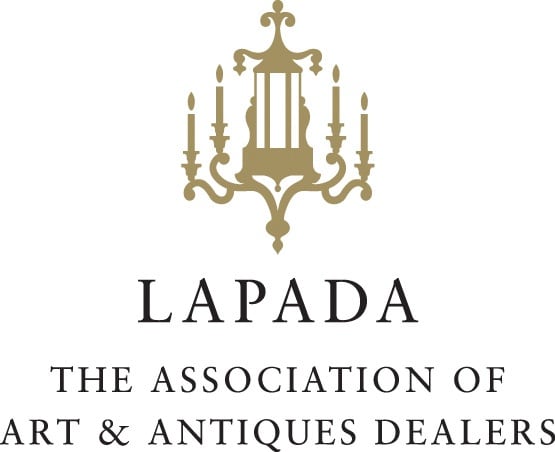Henry Orlik b. 1947
Framed: H. 82 cm. x W. 95.5 cm., H. 32¼ in. x W. 37½ in.
Further images
In Celtic Symbol, two naked female figures confront each other. They stand either side of a wall in a hilled landscape brandishing swords. They are similar in appearance, with sturdy bodies and a firm stance on wide apart, stocky legs; they brandish arched swords which appear like tusks or teeth from a sabre-toothed tiger or woolly mammoth and both have a long mass of hair which swings out in an arc, reaching to a point. The hair of the figure on the left swinging forward in front of her and the hair of the figure on the right swinging behind, like a windsock.
The green ground is made up of a rhythmic mass of green mounds, reminiscent of tumuli (Neolithic burial mounds) and the title of the painting, ‘Celtic Symbol’, suggests an ancient landscape like the famous ancient Wiltshire landscape which surrounds Stone Henge and Avebury, near where Orlik grew up, which is suffused with burial mounds. The two swords which are also tusks, suggests the tools made from animal antlers that the ancients used as weapons and for digging out the landscape (such as the large ditches at Avebury). The mounds are also suggestive of green army helmets and Orlik depicted a similar landscape in his painting Cannon Balloons. Here the mounds also anthropomorphise into the suggestion of heads, arms and legs ‘swimming’ in the landscape which suggests the figure in Orlik’s painting Escape II. The landscape then becomes embodied as a mass of human living beings. This is a concept from ancient cultures suggesting Gaia herself and the mythical Celtic world when the natural landscape was personified as woman; in The Mabinogion, for example, as the ‘life-giving, creative power of the Earth; and the ‘Cailleach Bhéarra, the diving hag, the old woman who shaped the land’ (Sharon Blackie, If Women Rose Rooted, 2016, p. 211). It also becomes a commemoration of a timeless landscape and the teeming generations of nameless people who have lived, fought and died on the land (as referenced in the ‘burial’ mounds).
Running through the landscape, dividing the two people, is a russet-coloured wall. The wall is composed of a geometric rhythm of shapes, suggesting the random nature of the wall; it comprises arches, steps, squares, triangles, with different shaped holes and entry points along it perhaps suggesting different forms of architecture around the world. It is low and could easily be breached and it raises the question of who is being kept out and who in. It becomes a token wall, a symbol of any ‘wall’ (or structure) that separates people, but is immediately redolent of ancient walls or dykes such as Hadrian’s Wall, Offa’s Dyke and the Great Wall of China. It also, of course, brings to mind more modern structures such as The Berlin Wall and the Peace Lines in Northern Ireland. The wavy nature of the wall suggests the random nature of the structure – it follows no rational route but weaves its way between the figures like a winding river (although a river would presumably have formed valleys – here the wall goes up and down the mounds).
Beneath each figure, Orlik paints a definite shadow. The shadow of the figure on the left is suggestive of a scorpion and the shadow of the figure on the right is suggestive of a starfish. On the phylogenetic tree, the scorpion belongs to the group of animals known as arthropods and the starfish the group known as echinoderms; their lineages split hundreds of million years ago but both evolved through cephalization from bilateria and share an awareness of their environment to catch prey and evade predators. Orlik here, therefore, is emphasising the shared genetic heritage of the two figures (who here appear identical). They are, however, divided by a wall and view each other as the enemy from whom they must defend themselves and their territory. Orlik is suggesting the shared heritage of numerous divided people who live next to each other but whose neighbours have become the enemy being separated by political or religious divides (such as the Republic of Ireland and Northern Ireland, West and East Germany, North and South Korea). This was particularly pertinent for Orlik’s family as Belarus became part of the Soviet Union after first being invaded by the Nazis. As with Cannon Balloons, the green mounds which are also army helmets, suggest how both sides wear the same helmets in warfare so that the human wearing the uniform becomes anonymous and indistinguishable from his enemy.








